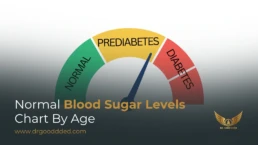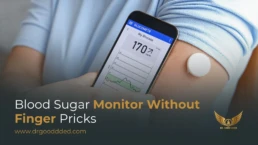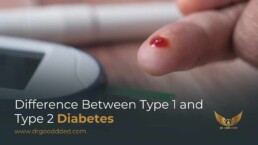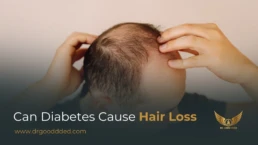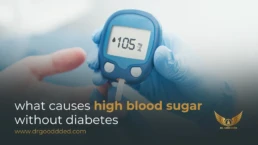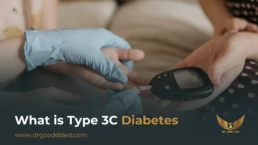Diabetes can cause hair loss. When blood sugar levels stay high for long periods, your body’s small blood vessels and nerves start to weaken. These tiny vessels carry oxygen and nutrients to your hair roots, known as hair follicles. When they stop working properly, hair may stop growing or fall out faster than normal.
Table of Contents
ToggleHow Diabetes Affects Hair Growth
When you live with diabetes, your blood sugar levels can swing up and down. Over time, these ups and downs affect your circulation. Hair follicles need a steady blood supply to stay alive and active. Without it, your hair growth slows or stops.
High blood sugar also affects hormones that control hair growth. Hormonal changes can make the hair weak or thin. In some people, stress caused by diabetes management can add another layer of strain on your body and hair health.
The Hair Growth Cycle Explained
Hair doesn’t grow all at once. It moves through three main stages:
| Hair Growth Stage | What Happens | Duration |
| Anagen (growth phase) | Hair grows from the follicle. | 2 to 7 years |
| Catagen (transition phase) | Hair stops growing but stays in place. | 2 to 3 weeks |
| Telogen (resting phase) | Hair sheds, and new hair begins to form. | 3 to 4 months |
In healthy people, about 85% of hair is in the growth phase. But when blood sugar stays high, more hair moves to the resting phase, which means you lose hair faster than it regrows.
When Blood Sugar Interferes With Hair Follicles
When glucose levels stay high, your small blood vessels shrink or become blocked. That means less oxygen and nutrients reach your hair follicles. Over time, these follicles shrink and weaken. You may notice your hair growing thinner, slower, or falling out in clumps.
This can happen anywhere on the body, not just the scalp. Some people also experience diabetic hair loss on their legs because of poor blood flow in the lower body.
The Role of Hormones and Stress in Hair Loss
Diabetes disrupts insulin, which is a hormone that helps control blood sugar. When insulin levels go off balance, other hormones like cortisol (the stress hormone) and thyroid hormones also change. This imbalance can make hair enter the resting or shedding phase too early.
Stress from living with diabetes can worsen the situation. Stress increases inflammation (swelling inside your body) and makes it harder for hair to grow. So, stress management plays a big part in keeping your hair healthy.
Diabetes Medications and Hair Thinning
Sometimes, hair loss happens as a side effect of certain medicines used for diabetes. Drugs that change hormones or blood flow can cause temporary shedding. If you start losing hair after switching medication, don’t stop it suddenly. Talk to your doctor about it. They may suggest an alternative or recommend a supplement to protect your hair.
Types of Diabetes-Related Hair Loss
Hair loss from diabetes can appear in different forms depending on your health, blood sugar control, and stress levels.
Diffuse Hair Thinning (Telogen Effluvium)
This is the most common type. Hair becomes thin across the entire scalp rather than in one area. The main trigger is stress on your body, such as an illness, infection, or a sudden blood sugar change. The good news is that this type is often temporary. Once your body stabilizes, hair usually regrows within six to nine months.
Alopecia Areata – The Autoimmune Connection
Alopecia areata happens when your immune system attacks your own hair follicles. Since type 1 diabetes is also an autoimmune disease, the two can appear together. You may see round bald patches on your head or beard area. Early treatment helps prevent it from spreading.
Hair Loss in Women With Diabetes
Diabetes hair loss in women often experience hair thinning due to both high blood sugar and hormonal changes. Women with type 2 diabetes may also have polycystic ovary syndrome (PCOS), a condition that raises male hormones. This can make hair thin on the scalp and grow in places like the chin.
Hair Loss in Men With Diabetes
Men with diabetes may face both diabetes and hair loss, the usual male-pattern baldness caused by genetics. Diabetes speeds up hair loss by weakening follicles and slowing regrowth. Men might also lose hair on the arms, legs, or chest if circulation worsens.
Diabetes Hair Loss on Legs and Body
Diabetes hair loss on legs usually means reduced circulation or nerve damage. The skin on your legs might look shiny or patchy. This can be an early warning sign of peripheral artery disease, a common diabetes complication. If you notice this, it’s time for a medical check-up.
Signs You’re Losing Hair Due to Diabetes
Hair loss linked to diabetes has certain signs that make it different from everyday shedding.
How to Tell It’s Not Normal Shedding
You normally lose around 50 to 100 hairs a day. If you’re losing much more, or if hair seems to fall in handfuls when you wash or brush it, it’s not normal. You might also see thinning around your temples, crown, or even your body.
Related Symptoms to Watch
Other clues include:
- Tingling or numbness in your feet or hands
- Slow-healing cuts or sores
- Dry or itchy scalp
- Changes in skin texture
These signs suggest your blood sugar is not under control and is affecting your circulation.
Can Managing Diabetes Help Regrow Hair?
Yes. You can improve your hair health by improving your blood sugar control. Many people who stabilize their sugar levels notice stronger hair within months.
Blood Sugar Control Comes First
Keeping your normal blood sugar level helps restore circulation and reduces inflammation. That means better oxygen and nutrient flow to your follicles. Follow your prescribed diet, take your medicine on time, and monitor your levels daily.
Nutrition and Vitamins That Support Hair Growth
Your hair needs certain nutrients to grow properly. Lack of these can worsen hair loss. Here are a few important ones:
| Nutrient | Why It Matters | Food Sources |
| Protein | Builds hair structure | Eggs, chicken, beans |
| Iron | Helps blood carry oxygen | Spinach, red meat |
| Zinc | Repairs hair tissue | Nuts, seeds, lentils |
| Biotin (Vitamin B7) | Promotes growth | Eggs, avocado |
| Vitamin D | Stimulates follicles | Sunlight, fish |
Ask your doctor to test for any vitamin or mineral deficiency before starting supplements.
Lifestyle Tips for Healthier Hair With Diabetes
Exercise daily, even if it’s a short walk. Movement increases blood flow. Sleep for at least 7 hours each night. Manage stress with yoga or meditation. Avoid smoking, as it narrows blood vessels. Simple changes make a big difference in how your hair and skin look.
Medical and Cosmetic Treatments
If you already have visible thinning, your doctor might suggest treatments like:
- Minoxidil (a topical solution that stimulates hair growth)
- Platelet-rich plasma (PRP) therapy
- Low-level laser therapy
These treatments can be part of diabetes and hair loss treatment plans, but should always be supervised by a doctor familiar with your condition.
Natural Remedies and Home Care
Massage your scalp daily with gentle pressure to boost circulation. Use mild, sulfate-free shampoos. Avoid tight hairstyles, hot tools, and harsh chemicals. Stay hydrated and eat balanced meals. Natural remedies won’t replace medical treatment, but they can support healthier hair.
Reversing Hair Loss: What Actually Works
Many people ask if they can fully reverse hair loss caused by diabetes. The answer depends on how early you act.
Is Hair Loss From Diabetes Reversible?
In many cases, yes. If hair loss comes from poor blood flow or stress, regrowth is possible once your sugar levels and health stabilize. But if nerve or blood vessel damage is severe, the hair might not return.
Realistic Expectations
Even with perfect control, hair takes time to grow. You may need to wait 3 to 6 months before seeing improvement. Patience and consistency matter more than quick fixes.
Combination Therapies for Best Results
The best results often come from mixing approaches: stable blood sugar, balanced diet, stress control, and safe topical treatments. Combining natural care with medical support gives your hair the best chance to recover.
When to See a Doctor
If you notice sudden hair loss, patches, or bald spots, see a healthcare provider. Don’t wait. They can check your blood sugar, thyroid, and iron levels and guide you toward a treatment plan before the damage becomes permanent.
Living With Diabetes & Hair Loss — Mind Over Mirror
Hair loss can shake your confidence. But you’re not alone. Many people manage both conditions successfully and feel good about themselves again.
Emotional Health and Confidence
Losing hair can affect your mood. Talk to someone you trust or join a diabetes support group. Self-care goes beyond medicine; it’s also about mental health.
Building a Supportive Routine
Set a simple routine for your hair and body. Eat on time, take medicines as prescribed, and make time for rest. These small habits build strength inside and out.
FAQs
Does diabetes really cause hair loss?
Yes, diabetes causes hair loss by damaging blood vessels and hair follicles. When circulation drops, your hair stops receiving nutrients and begins to thin.
Can diabetes cause hair loss on the legs or other body parts?
Yes, diabetes causes hair loss on the scalp, legs, and arms due to poor circulation. Hair loss on the legs can be an early warning of blood flow issues.
Is hair loss from diabetes permanent?
It can be reversed if caught early. Once blood flow and sugar control improve, hair may regrow, but long-term damage may lead to permanent loss.
How can diabetic women manage hair thinning?
Women facing diabetes hair loss should balance hormones, maintain blood sugar, and check vitamin levels. Medical and cosmetic care can support hair regrowth.
What treatments help regrow hair if I have diabetes?
Diabetes and hair loss treatment options include topical medicine, PRP therapy, and improved nutrition. Regular doctor visits ensure the safest combination for you.
Does insulin therapy cause hair loss?
Insulin itself doesn’t cause hair loss. Hair shedding is more linked to blood sugar imbalance or stress rather than insulin therapy.
Can controlling blood sugar reverse hair loss?
Yes, stable blood sugar improves circulation and helps follicles recover. Diabetes causes hair loss, and it can be reversed when you manage your condition properly.

This article is medically reviewed by Dr. Nivedita Pandey, Senior Gastroenterologist and Hepatologist, ensuring accurate and reliable health information.
Dr. Nivedita Pandey is a U.S.-trained gastroenterologist specializing in pre and post-liver transplant care, as well as managing chronic gastrointestinal disorders. Known for her compassionate and patient-centered approach, Dr. Pandey is dedicated to delivering the highest quality of care to each patient.



